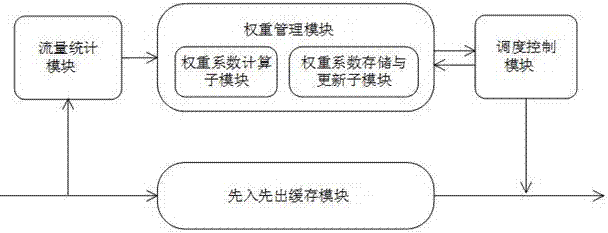Hierarchical weighted round-robin (WRR) scheduling device and method
A weighted polling and scheduling device technology, applied in the field of communication, can solve the problems of limiting network service quality, network performance, increasing network construction costs, and low link utilization, so as to improve network performance and network service quality, and reduce network traffic. Construction cost, the effect of avoiding network congestion
- Summary
- Abstract
- Description
- Claims
- Application Information
AI Technical Summary
Problems solved by technology
Method used
Image
Examples
Embodiment 1
[0071] Refer to attached figure 2 , a hierarchical weighted round-robin scheduling method, the implementation steps are as follows:
[0072] Step 1, assign weight coefficients to each queue DC i :
[0073] 1a) Let there be a total of P priorities, each priority corresponds to a queue, a total of P subqueue;
[0074] 1b) Let a scheduling period be N time slots or packets with a priority of i The queue for Q i , in every N The number of packets backlogged in the queue in a time slot is N i ;
[0075] 1c) Calculate P The total number of backlog packets in subqueues is N all ,Right now ;
[0076] 1d) Calculate the weight coefficient of each priority w i , ;
[0077] 1e) Store the weight coefficients of each priority in the weight coefficient storage module, and the weight coefficient storage module is each priority queue Q i Maintain a weight coefficient counter DC i , at the beginning of each scheduling cycle DC i = w i .
[0078] Step 2, dete...
Embodiment 2
[0103] Refer to attached image 3 , in this embodiment, there are four types of priorities provided by the system, and a FIFO queue is maintained for each priority service, and the scheduling cycle N = 8, priority 0 is the highest, priority 1 is next, and so on; in this embodiment, the number of backlog packets in the 0th priority queue is 4, the number of backlog packets in the 1st priority queue is 8, and the number of backlog packets in the 2nd priority queue is 8. The number of backlog packets in the priority queue is 2, and the number of backlog packets in the third priority queue is 2. The specific steps are as follows:
[0104] Step 1, assign weight coefficients to each queue DC i :
[0105] The number of backlog packets in each priority queue is obtained through statistics, and the weight coefficients of each priority business are obtained according to the weight coefficient calculation method as follows: w 0 = 2, w 1 = 4 ,w 2 = 1, w 3 = 1; the obtaine...
Embodiment 3
[0125] Refer to attached Figure 4 , in this embodiment, there are 4 kinds of priorities provided by the system, and a FIFO queue is maintained for each priority service, priority 0 is the highest, priority 1 is the second, and so on; scheduling cycle N = 8, in this embodiment, the backlog grouping number in the 0th priority queue is 2, the backlog grouping number in the 1st priority queue is 6, the backlog grouping number in the 2nd priority queue is 6, the 3rd priority queue The number of backlog groups is 2, and the specific steps are as follows:
[0126] Step 1, assign weight coefficients to each queue DC i :
[0127] The number of backlog packets in each priority queue is obtained through statistics, and the weight coefficients of each priority business are obtained according to the weight coefficient calculation method as follows: w 0 = 1, w 1 = 3 ,w 2 = 3, w 3 = 1; the obtained weight coefficient is assigned to the weight coefficient counter, DC 0 =...
PUM
 Login to View More
Login to View More Abstract
Description
Claims
Application Information
 Login to View More
Login to View More - R&D
- Intellectual Property
- Life Sciences
- Materials
- Tech Scout
- Unparalleled Data Quality
- Higher Quality Content
- 60% Fewer Hallucinations
Browse by: Latest US Patents, China's latest patents, Technical Efficacy Thesaurus, Application Domain, Technology Topic, Popular Technical Reports.
© 2025 PatSnap. All rights reserved.Legal|Privacy policy|Modern Slavery Act Transparency Statement|Sitemap|About US| Contact US: help@patsnap.com



